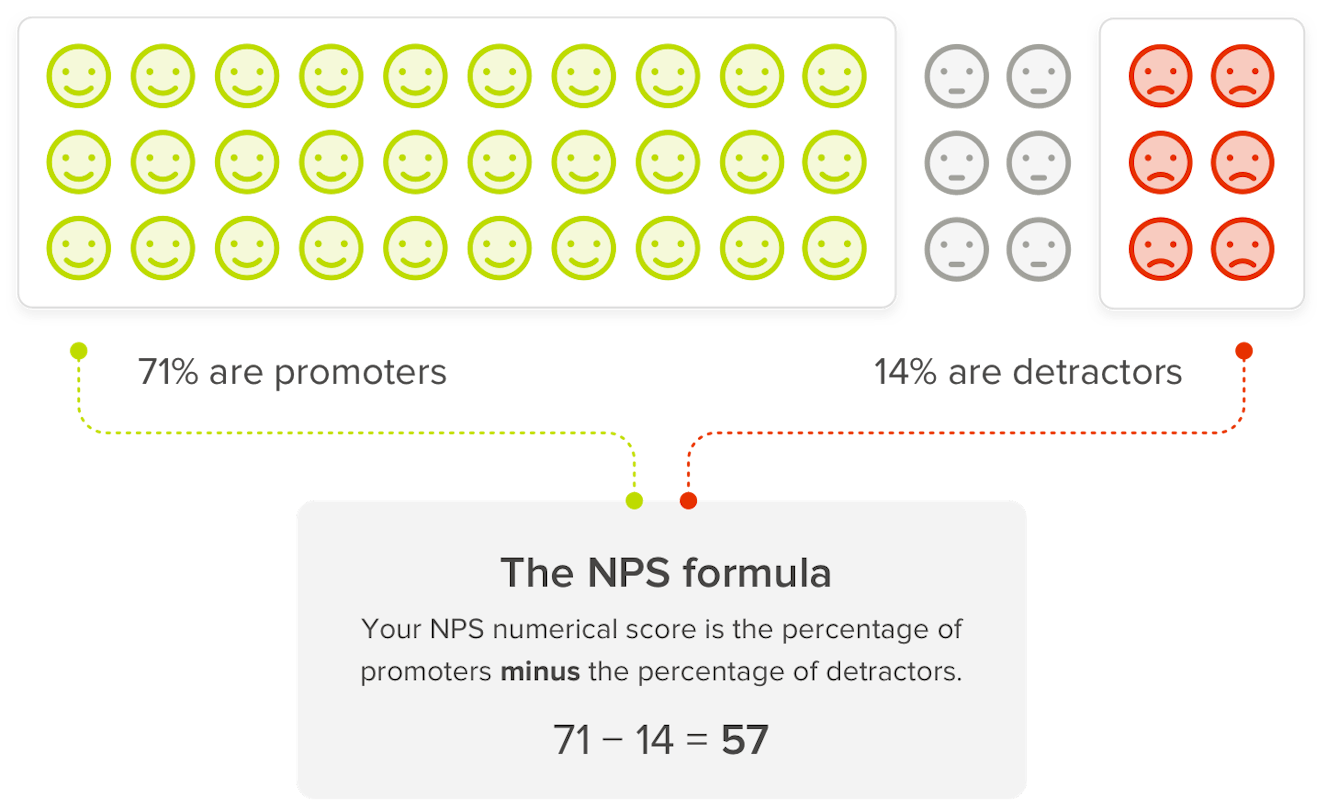If you’ve been in the customer experience (CX) space for any length of time, you’ve probably heard a few buzzwords tossed around regarding how to measure CX. And you can’t get far into a conversation about measuring CX without hearing the term “NPS.”
Perhaps you’re just starting to explore potential ways to keep tabs on how your customers are feeling, or maybe your team has recently decided to implement a Net Promoter Score (NPS) program. Either way, there are some NPS basics that are helpful to know before diving in.
What is NPS?
Net Promoter Score is a system developed by Bain & Co. in the early 2000s to measure customer loyalty. Researcher Fred Reichheld and his team wondered (as did many companies) if there was a specific survey that could be used to predict whether a customer would continue to purchase from their business in the future.
After analyzing survey data and comparing it to purchase histories, they narrowed in on not a single survey, but a single question: the Net Promoter question. What’s even better is that this question was tied not just to customer loyalty, but also to brand advocacy, repeat purchases, upgrades, renewals, and positive referrals.
What is this magic question? It’s simple. Measured on a scale from 0 to 10, the Net Promoter Score question asks:
How likely are you to recommend (this brand/product) to a friend?
Following this question should be an open-ended question where respondents can give context into their score choice (such as, “Tell us a bit more about why you chose 10,” or “What’s one thing we could do to improve your response by even one point?”).
The other key to the NPS system is the score calculation:
Customers rating a 9 or 10 are known as Promoters. They’re highly likely to recommend your company to their friends and can become powerful advocates for your brand.
Customers giving a score of 7 or 8 are Passives, and they’re on the fence. They won’t go out of their way to recommend you to others, but they might do it if asked. However, these customers can also be swayed in a negative direction if your customer experience doesn’t stay up to par.
Customers giving a score of 0 to 6 are Detractors. These customers are dissatisfied — and what’s worse, may even go so far as to tell others not to do business with you. It’s important to identify Detractors so that you can lean in and make positive changes to their experiences.

To calculate your NPS score, simply take the percentage of respondents who are promoters and subtract the percentage of respondents who are detractors. If 50 respondents are Promoters and 20 are Detractors, your NPS score is 30 (50% - 20%). This means that NPS is measured on a scale from -100 to +100.

Why use NPS for measuring customer experience?
Feedback is key to the success of companies, especially in the highly connected world we live in today. On a macro level, customer feedback can tell you what you’re doing well, where you need to improve, and where processes might be breaking down.
On a micro level, capturing customer feedback allows you a direct line to your most satisfied customers — helping you turn them into brand advocates — as well as the ability to directly follow up with dissatisfied customers, digging into their experiences, addressing their concerns, and turning their experiences around.
When should I send an NPS survey?
The path that a customer takes as they interact with your company — such as exploring your offerings, viewing a demo, and then purchasing — is known as the customer journey.
Along the customer journey are touchpoints, or places where you connect with the customer, whether it be through your marketing, your sales team, your customer service, or even your products themselves.
The customer journey unique to your organization is important in determining when to send out NPS surveys.

There are two main types of NPS programs, defined by when you send out your surveys:
Relational NPS programs involve sending NPS surveys to your customers on a regular basis, such as every three or six months. If you run a B2B or SaaS company, Relational NPS programs are a great choice because you can check in with your customers once a relationship has been established, they’ve had time to form an opinion of your organization, and are ready to give feedback on their experiences.
Transactional NPS programs involve sending NPS surveys to your customers after a certain touchpoint or distinct interaction with your company. For example, an ecommerce company might send out its NPS survey two weeks after an order is delivered with the request for feedback pertaining to that order.
You can combine transactional and relational NPS surveying to level up your CX program as time goes on.
For example, you might want to send an NPS survey to your customers after their initial onboarding meeting, then every three months thereafter. This allows you to collect point-in-time feedback about the onboarding process, while also capturing ongoing feedback about your brand as a whole.
For more information on timing by industry, check out this full guide on when to send NPS surveys.
How should I distribute my NPS survey?
As an easy rule of thumb, you should distribute your NPS survey through whatever platform your customers are most used to interacting with you.
For example, if most of your customers interact with your company or make purchases using your mobile or web app, then in-app surveys are the way to go. But if most customers interact with your company on your website, then web-based surveys are your best bet.
You can also survey via SMS messages, QR codes, kiosks in physical locations, or the tried and true email distribution method.
It’s important to keep in mind that the platform in which you survey your customers will impact the type of feedback you receive.
For example, if you place your survey on your website, you’re likely to get feedback about how the website operates, what functionality it offers, etc., which is great — unless you wanted feedback on your implementation process. In that case, email surveys are a better bet, as your implementation team would have been connecting with your customers via email throughout the onboarding experience.
7 best practices for using NPS to measure customer experience
Before you jump in and start sending out NPS surveys, read through these seven best practices for using NPS to measure and evaluate your customer experience.
1. Focus on recency in selecting your customer list
Looking to get a baseline for your NPS score before starting up a full program? Focus on surveying customers who have had a recent touchpoint with your company.
Maybe they’ve made a purchase in the last month, logged onto your website in the last week, or downloaded your app in the past quarter. These customers will be much more likely to respond and give relevant feedback because they’ve had a recent experience to draw from!
2. Capture operational data along with experiential data
Context is everything when it comes to analyzing your NPS feedback to drive impactful change. If all of your detractors have purchased something from a specific line of products that your brand offers, that’s key insight into the need for an update to that line. But it’s only helpful if you actually know what product a customer purchased.
When sending out your surveys, include operational details about your customers so that you can use that data to slice and dice the feedback you receive.
3. Send earlier in the day/week
We all know the struggle of a full inbox, especially at the end of the work day or a long week. Sending your surveys out so that they hit your customers’ inboxes at the beginning of the week, when they’re first logging in to check their emails, helps ensure that emails are seen and acted on.
Even better, send a gentle reminder a week later to anyone who hasn’t opened your survey email — give them a chance to share their feedback in case they missed your first note.
4. Personalize your survey
People love to feel known. Update the subject message of your survey email to include your customer’s name or reference a product they recently purchased. This increases the likelihood that you’ll get a response, plus it creates a connection with your customer that can only boost your brand.
5. Close the loop
Customers may give feedback to a black hole once, but they’ll quickly stop taking the time if they realize their feedback isn’t being acted on.
Aim to respond to Detractors within three days, Passives within five, and Promoters within seven — ask for more details about what could have improved their experience, address specific concerns they mentioned, or thank them for their time and their encouragement!
6. Share feedback with the team
To get your whole team on board with your NPS program, involve them in the feedback process!
If your team uses Slack or another messaging software, set up an automation to funnel feedback into a dedicated channel where teammates can get a boost from positive feedback and troubleshoot anything negative together.
As the voice of the customer is infused throughout your everyday operations, your team will make better decisions that improve the customer experience.
7. Tie NPS to other KPIs
Need executive buy-in? How about proof that detractors are less likely to make return purchases or that promoters churn at a 75% lower rate? By tying your NPS to other KPIs that your team cares about, you can prove that the customer experience really does have a dollar value.
Acting on customer experience data
This section was written by Delighted's Jack Gerli. Jack partners with Delighted customers as they lay the foundation for their Voice of Customer programs and realize the business value in CX data. When he's not online, he's biking, teaching skiing, or working on his old Toyota. Connect with him on LinkedIn.

Jack Gerli
Delighted
Collecting feedback is the natural first step in building out a customer experience program — Ellie has done a brilliant job above of mapping out what you can do to start listening to customers with a simple NPS program.
As feedback starts flowing in, patterns in customers’ needs, common issues, and product preferences begin to emerge. Now, it’s time to act and to close the loop with customers.
Closing the loop (the micro and macro)
By closing the loop, you prove to customers that you’ve heard their feedback and that you take it seriously. According to the team that created NPS, “Closing the loop is a central element of the Net Promoter System.”
To truly extract value from your customer experience program, your organization will have to start acting on customer sentiment both on the micro and macro levels.
The micro
Let's say a dissatisfied customer has let you know that their preference is to self-support. However, they’ve struggled to access help articles through your support center. This feedback points to a very specific issue with your help center — documentation is unorganized and difficult to access.
Now, if you make an immediate attempt to correct the customer’s situation and point them in the direction of applicable documentation, you’ve addressed their pain. If you can also guide them towards best practices for self-service, bonus points.
Addressing a customer’s immediate pain is commonly referred to as “closing the loop” or addressing the “inner loop.”
The macro
This customer’s specific feedback flags a trend for your self-serve customer base. Your support documentation just isn’t as “self-serve” as they expect.
This is a recurring pain point that has been experienced and shared by multiple customers — it’s potentially a hidden issue that a larger segment of customers is experiencing but not directly pointing out in their feedback.
This trend requires sweeping, structural changes to how your support center is organized. And when fixed, the experience for many customers will likely improve. Addressing systemic issues is also a form of “closing the loop,” specifically the “outer loop.”
Inner and outer, closed-loop processes are never a one-time occurrence. Be diligent about addressing the inner loop — explore Delighted’s best practices as you build these processes. Be habitual about addressing the outer loop.
Managing the outer loop
Regardless of where your program is in its maturity cycle, there are two methods for measuring performance that work best when done together. These measures include:
Benchmarking.
Identifying drivers: Tracking sentiment across user stories and segments.
From a macro level, these measures will help you understand what to expect from your CX metrics, while drawing you towards laggard experiences that may be ripe for outer loop review.
Benchmarking your scores
When reviewing a program from a high level, benchmarking is oftentimes the easiest place to start. Think of benchmarking as addressing the questions, "How are we doing in comparison to other companies in our industry?” and “What does good look like?”
With curated benchmarks, you can easily review your company's NPS score alongside others in your industry. Keep in mind that this data is simply a starting point for further exploration — all programs measure NPS at different stages of the customer funnel and target different customer subsets, which can lead to variability in scores.
While comparing your scores to other companies can be useful, the best customer experience programs also build internal benchmarks to expose deeper patterns in customer sentiment; the most important and actionable benchmarks are those that are internal to your business.
With internal benchmarks, you can create granular views into what is driving NPS and the overall customer experience. Some questions to consider:
Which elements of the customer experience are most closely tied to NPS?
Which drivers have the biggest impact?
Which drivers provide the biggest opportunities for improvement?
Identifying drivers: Tracking sentiment across user stories and segments
“Experience drivers” are the measures that drive change in NPS. A few examples include whether a customer experienced a problem in support, the length of wait time in a store, ease of completing a transaction on a website, and pricing and product selection.
Properly designed driver analysis is done on a quarterly basis and will inform what areas to take action on in your outer loop process. In the world of Delighted, driver analysis is accomplished with Trends — these are saved searches composed of keywords and customer metadata.
Trends help teams quantify changes in behavior patterns, identify whether positive/negative movement is significant, and determine if these patterns are different for certain customer groups.
If NPS has gone down, what is driving that movement, how does the inner loop validate that change and what can we do to remedy the situation for as many customers as possible?
Further reading
Closing the loop with customers is one of the clearest ways to prove value in a customer experience program. Start with the micro, then extend to the macro. As you think about applying these practices, take a peek at some of our favorite articles for additional guidance:
When in doubt, keep it simple
Simplicity is at the core of the NPS methodology. The best aspects of NPS feedback — the high response rates and the unfiltered feedback — all stem from a quick and simple survey format that is a positive customer experience in itself.
Don’t overcomplicate things: Over time, you can always layer on more touch points into your CX program, but simplicity is always a great strategy for an NPS survey.
As the marketplace becomes more and more crowded and customers have seemingly unlimited options to choose from when making purchasing decisions, customer experience becomes the key differentiator that can help you make sales, retain customers, and grow your business.







